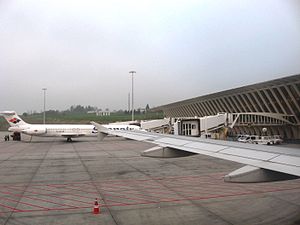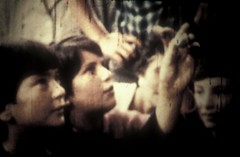
LOCATION
Garabandal is located in the north west of Spain about three hours
 drive from the French border town of Irun. It is an hour and fifteen minutes drive south of Santander, (80.6 km) a substantial coastal city where the Bishop of the diocese resides. (See Michelin map 572 Regional Espana).
drive from the French border town of Irun. It is an hour and fifteen minutes drive south of Santander, (80.6 km) a substantial coastal city where the Bishop of the diocese resides. (See Michelin map 572 Regional Espana).TRAVELLING BY CAR
From Madrid it is a day drive. The shorter route to Garabandal is via Burgos, Corconte, Reinosa, Cabuerniga, Puentenansa and Cosio. The longer but better route is via Burgos, Vargas, Torrelavega, Cabezon de la Sal, Cabuerniga, Puentenansa and Cosio. Both routes are good. The road from Puentenansa to Cosio is undergoing major upgrading.
From Santander it is about an hours drive to Cosio. The freeway south is excellent. You take the turnoff at Pesues to Puentenansa and on to Garabandal, or you can turn off earlier to Cabezon de la Sal and travel the mountain route.
TRAVELLING BY TRAIN
From Madrid, catch the RENFE train at Chamartin station to Santander (about five hours). Book first class for more comfortable seating. Hotel Chamartin (good accommodation) is next to the train station.
 Image via Wikipedia
Image via WikipediaFrom Santander catch the FEVE train to Cabezon de la Sal. This train departs every hour from 6.15 am to 20.15 pm and takes about one hour at a cost of 2.50 Euros. Take a taxi to Garabandal, about a half hour drive at a cost of 40 Euros. If none available at the station, telephone Jose on 609 442210.
TRAVELLING BY PLANE
The airport, located 5 kilometres to the east of the city centre, has domestic flights connecting Santander with Barcelona and Madrid and Ryanair International flights from London Stansted, Rome-Ciampino and Frankfurt-Hahn.
NB As Ryanair is a low cost budget airline, it is important to be aware of their strict baggage regulations. Each passenger is allowed free of charge, one piece of cabin baggage weighing no more than 120 kg with maximum dimensions of 55 cm x 40 cm x 20 cm. If your total baggage does not meet these guidelines, then refer to www.ryanair.com to check on their strict terms and conditions of travel for carrying your baggage in the aircraft hold.
There is a permanent bus service which connects Santander Airport with the city centre bus station every 30 minutes. The bus ticket costs approximat
 Bilbao Airport. Image via Wikipedia
Bilbao Airport. Image via WikipediaAdditionally, Bilbao Airport, situated about 110 kms from Santander, operates international flights to and from the main European capitals. There are buses and trains to and from Bilbao Airport to the city centre, where there is a coach service to Santander.
ACCOMMODATION
Sari's Hotel offers very good accommodation, great food, wine and bar facilities. Phone number is 34 (Country code) 9 4272 7145. Miguel Angel Gonzales (the Village Mayor), also offers home style accommodation and meals. Phone number is 34 (Country code) 9 4272 7113.

 PHOTO: In the history of apparitions, it is only in Garabandal that the Blessed Virgin identified herself as Jewish, saying that even in heaven, she belonged to the Jewish people.
PHOTO: In the history of apparitions, it is only in Garabandal that the Blessed Virgin identified herself as Jewish, saying that even in heaven, she belonged to the Jewish people.  Photo: At the Wailing Wall, the holiest shrine of the Jewish world:All the Jews who have a thorough knowledge of their Scriptures will be interested in the appearance of a pillar of smoke at Garabandal.
Photo: At the Wailing Wall, the holiest shrine of the Jewish world:All the Jews who have a thorough knowledge of their Scriptures will be interested in the appearance of a pillar of smoke at Garabandal. 




![Reblog this post [with Zemanta]](http://img.zemanta.com/reblog_e.png?x-id=56c24576-0f88-4ac3-8bd9-5c93c5e684da)






 You will receive marvelous favors through the Blessed Mother’s intercession. If you work for the Blessed Mother, she is a wonderful, loving employer. But you cannot work for someone whom you don’t love, and you cannot love someone whom you don’t know. So find out about Mary. Read about her at Garabandal; learn about the Padre Pio connection; hear what the Blessed Mother has to say. Every little thought has a message for you. Before you begin reading, say a prayer to Mary, who is the spouse of the Holy Spirit. Ask her, “What would you have me know today? What would you have me do today so that I can bring Jesus with me through the world, wherever I go, whomever I am with, today.” And she will answer you.
You will receive marvelous favors through the Blessed Mother’s intercession. If you work for the Blessed Mother, she is a wonderful, loving employer. But you cannot work for someone whom you don’t love, and you cannot love someone whom you don’t know. So find out about Mary. Read about her at Garabandal; learn about the Padre Pio connection; hear what the Blessed Mother has to say. Every little thought has a message for you. Before you begin reading, say a prayer to Mary, who is the spouse of the Holy Spirit. Ask her, “What would you have me know today? What would you have me do today so that I can bring Jesus with me through the world, wherever I go, whomever I am with, today.” And she will answer you. 
 In spite of the imprudence and unsettling hostility of certain priests, the children have never been heard to utter the least criticism of them or to show them the least discourtesy. They even make a special point of praying for them, especially for those who cause the children to suffer for reasons unknown to them.
In spite of the imprudence and unsettling hostility of certain priests, the children have never been heard to utter the least criticism of them or to show them the least discourtesy. They even make a special point of praying for them, especially for those who cause the children to suffer for reasons unknown to them.

![Reblog this post [with Zemanta]](http://img.zemanta.com/reblog_e.png?x-id=b17c2cc9-f8ce-4e67-9e62-ce3bcc3d3132)

 False Prophets
False Prophets